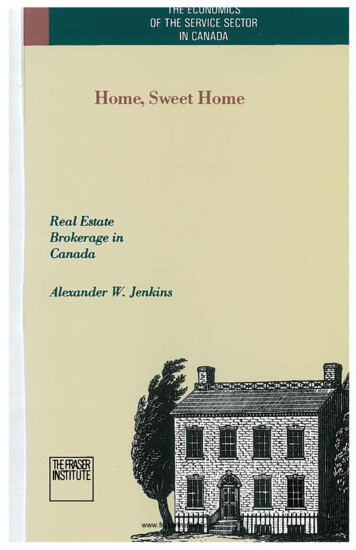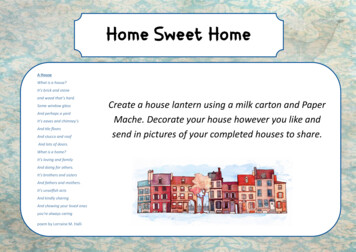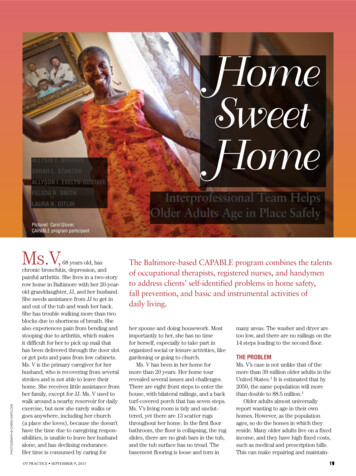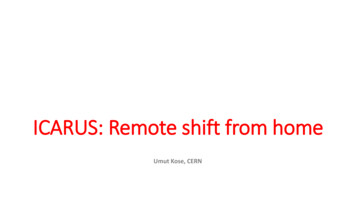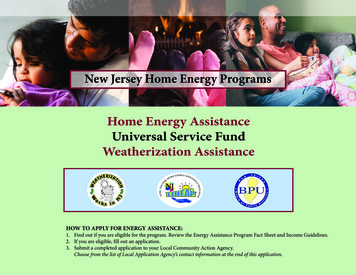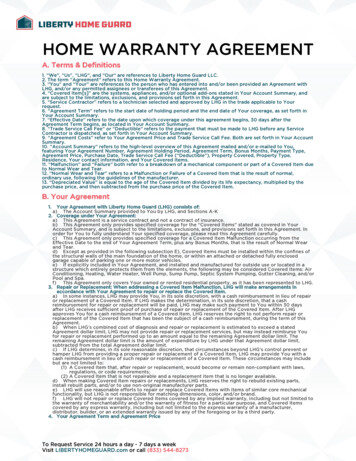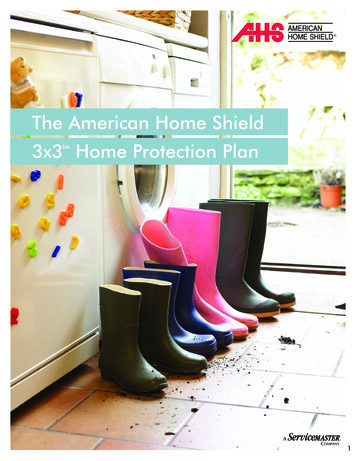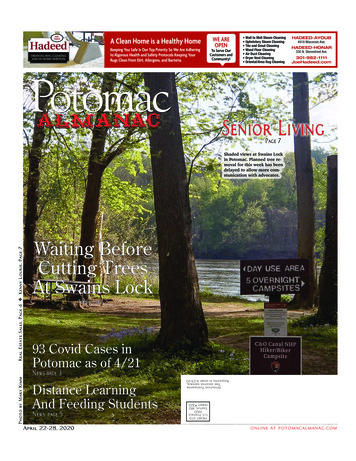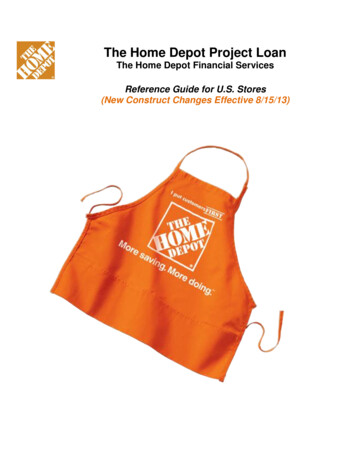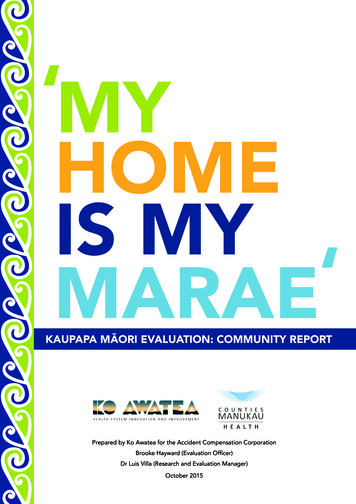
Transcription
‘MYHOMEIS MY‘MARAEKAUPAPA MĀORI EVALUATION: COMMUNITY REPORTPrepared by Ko Awatea for the Accident Compensation CorporationBrooke Hayward (Evaluation Officer)Dr Luis Villa (Research and Evaluation Manager)October 2015
This kaupapa Māori evaluation was funded and supported by the Accident CompensationCorporation (ACC), Wellington, New Zealand. Views and/or conclusions in this report aredrawn from the analyses of evaluation data completed by Ko Awatea’s Research and Evaluation Office (Counties Manukau Health) and may not reflect the position of ACC.
“We are trying to save whakapapa, not money”Injury Prevention Consultant, capturing Māori aspirations for ‘My Home is My Marae’i
ACKNOWLEDGEMENTSWe would like to express a deep appreciation to kaikōrero from provider organisationswho contributed to this evaluation kōrero- from Management to kaimahi who deliver theapproach in the whare of whānau. Your passion and enthusiasm to support whānau is aninspiration to the evaluation team and an asset to ACC and Māori communities.Thanks also to whānau who so courageously let kaimahi into their homes to tackle hazardshead on and make changes for the safety of our whānau- kuia, kororua, pākeke, tamarikiand mokopuna.Finally, thank-you to The Accident Compensation Corporation (ACC) who have supportedthe implementation of ‘My Home is My Marae’ and funded this evaluation with acommitment to improve this approach for the benefit of Māori communities.Heoi anō kia ACC mō o koutou tino tautoko I tēnei kaupapa whakahirahira “Ko tōkukainga, tōku marae”. Kia ora anō ACC mō o koutou tautoko I tēnei waitara me te whakanuiI te kaupapa.No reira, he mihi mahana anō kia tātou katoa.ii
EXECUTIVE SUMMARYThe ‘My Home is My Marae’ approach is designed to empower Māori communities bysharing knowledge and skills around safety in the home, which enables them to identifyand resolve/reduce hazards within their whare. Over an 18 month period from November2013 to June 2014, 14 ‘My Home is My Marae’ trials were conducted across SouthAuckland and Northland regions. This involved visiting at least 646 whare, including 2,897individuals, to conduct a home safety audit in partnership with whānau.The evaluation of these trials applied a Kaupapa Māori theory-based evaluation andAppreciative Inquiry methodologies to identify:1. Critical success factors of the ‘My Home is My Marae’ approach.2. Strengths and weaknesses of these trials against the ‘My Home is My Marae’objectives.The evaluation involved the participation of 14 kaimahi from six provider organisationswho shared their whakāro and experiences delivering ‘My Home is My Marae’ with theevaluation team. Existing information from Excel spreadsheets and monitoring reportswas also reviewed.From the evaluation kōrero, five key strengths of ‘My Home is My Marae’ emerged: Mana tangata (reputation, respect and credibility),Manākitanga (generosity and care for people),Kānohi-ki-te-kānohi (face-to-face discussion),Capacity building for kaimahi, whānau and providers as an organisation,‘Low cost/ no cost’ solutions to hazards in the home.Mana tangata and manākitanga were consistent themes in the kōrero of all kaimahi,and key strengths of the approach which ensure whānau engagement. These strengthsare intrinsic to the people who support and deliver ‘My Home is My Marae’: they carrylocal knowledge, speak the local language, are personally connected to whānau throughwhakapapa and their residence in local communities, and have the passion and integrityto deliver messages to whānau in a way that shows whānau they are valued and caredfor. As such, they facilitate an approach which is genuinely ‘by and for Māori’, and whichwhānau are receptive to.Key challenges of the approach were also explored. These included: funding, resourcedevelopment, and relationships within and beyond ACC integral to sustaining ‘My Homeis My Marae’ and addressing real issues in the homes of whānau. Approximately 76per cent of hazards identified and recorded in the Far North whare of whānau could beresolved through ‘low cost/ no cost’ solutions. However, 17 per cent required a ‘highcost’ solution that was either unaffordable for whānau, or the responsibility of otherstakeholders such as landlords . Kaimahi play a key role in advocating for whānau tohave high cost hazards or substandard housing addressed, and perceive that they areaccountable for this. This is important to understand when considering how ACC can bemore responsive to Māori aspirations of ‘My Home is My Marae’, and as more effectiveresources and funding models are developed.1The remaining 6 per cent were ‘not identified’ and 1 per cent had ‘no solution’.iii
Recommendations from this evaluation are operational (to improve the day-to-daydelivery of ‘My Home is My Marae’ on the frontline) and strategic (to better address Māoriaspirations). Decision making in partnership with provider organisations is emphasised inthese recommendations. Broadly, the recommendations cover: Resource development,Relationship development between ACC and providers,Relationship development between ACC and Government agencies.iv
CONTENTSAcknowledgements iiExecutive summaryiiiContents 1Introduction 2Background 3Completed trials 4Delivering a Home Safety audit with whānau- a narrative from kaimahi9Evaluation method 11Kōrero findings12Key Strengths of ‘My Home is My Marae’12Mana tangata and Low cost/ no cost’ solutions to hazards in the home18Challenges and opportunities19Funding19Resource development20Evaluation recommendations 24Te Reo Māori glossary26Evaluation terms glossary27References28Appendix A: Evaluation team profile291
INTRODUCTIONThe home is a key setting in which the majority of injuries leading to Accident CompensationCorporation (ACC) claims occur, with 790,466 new injury claims across New Zealand fromJuly 2014- June 2015 (ACC, 2015). Prevention of injury due to falls in the home is akey priority area for ACC. ACC is working to increase responsiveness to Māori throughpartnering with iwi/hapu and key Māori stakeholders to achieve effective injury preventionamongst whānau and Māori communities.ACC’s ‘My Home is My Marae’ kaupapa Māori approach to injury prevention aims toprevent falls in the home amongst Māori communities and whānau by: Empowering whānau with the knowledge and skills they need to identify hazardsin their home environment. Motivating whānau to take continued action to minimise, isolate or eliminatehazards in their home. Reducing the risk of incidence and/or severity of injury in the home.Over an 18 month period from November 2013 to June 2014, 14 ‘My Home is My Marae’trials were conducted across South Auckland and Northland regions through partnershipswith local Māori providers. This kaupapa Māori evaluation of the ‘My Home is My Marae’trials has been funded by ACC to explore:1. Critical success factors of the ‘My Home is my Marae’ approach.2. Strengths and weaknesses of these trials against objectives (these objectives arepresented above).Kaimahi from six provider organisations who have been identified as having well establishedtrials were invited to participate in this evaluation. These provider organisations include: Papatūānuku Kōkiri MaraeTamaki Makaurau Māori Women’s Welfare LeagueTe Kura Kaupapa Māori a Rohe o MāngereTumaitua Whānau TrustTe Hau Ora o Ngāpuhi (previously Kaikohe)Te Hau Āwhiowhio o Otangarei TrustThe whakāro of kaikōrero from these provider organisations form the basis of thisevaluation report. The report aims to identify what does and does not work for whānau,and to provide a resource for ACC, providers and the public, to assist in furtheringwork in injury prevention. It is intended to be simple and practical, and will be used toinform improvements in the ‘My Home is My Marae’ approach for the benefit of Māoricommunities.This evaluation report includes a brief background about the trials, the communities inwhich they have been delivered, and the types of hazards in the whare of whānau. Thisis followed by ‘Kōrero findings’, which details key strengths of the approach, as well askey challenges and opportunities for improvement that have been shared in kōrero withkaimahi. Finally, the evaluation report concludes with some recommendations about thefuture of ‘My Home is My Marae’.2
BACKGROUNDThe ‘My Home is My Marae’ approach is designed to empower Māori communities byproviding them with the knowledge and skills to enable them to be able to identify andresolve/reduce hazards within their homes in a culturally appropriate way. ‘My Home isMy Marae’ aims to work with the working age population (25 – 64 years of age) living inparticipating households, who are known to be at most risk of a fall in Māori communities.The approach also aims to be inclusive of the elderly parents, partners and children ofthose in the working age population residing at the same whare that will be visited.ACC engaged with local Māori providers to deliver the home safety intervention, as thisguaranteed a greater chance of success with messages coming via an established, trustedand recognised channel. Key milestones for the ‘My Home is My Mare’ approach aresummarised in Figure 1 below.Figure 1: Summary of key activities and milestones for the delivery of ‘My Home is My Marae’The first stage of the approach involved gaining commitment from Māori providers whowould engage with whānau in local communities across Northland and South Auckland.A selection of kaimahi from providers were then trained by ACC’s Injury PreventionConsultants to conduct home safety audits. This training involved equipping kaimahi withthe knowledge, skills and resources to capacitate whānau to identify and reduce hazardsthat risk injury in the whare through the implementation of ‘low cost/ no cost’ solutions.Kaimahi then conducted home safety audits in the homes of local whānau. As is explainedthroughout this report, this was not about walking into whare and completing a checklist,but working in partnership with whānau to raise the awareness of hazards in the home,and assist them in keeping their whānau- kuia, kororua, pākeke, tamariki and mokopunasafe. This involved: whakawhanaungatanga, delivering a home safety presentation andcompleting the checklist assessment; identifying current risks and hazards that can beaddressed immediately; increasing awareness of the risk of injuries in the home andpotential consequences; providing skills and knowledge for whānau to be able to identifyrisks/hazards in the home; providing ways to minimise, isolate or remove identifiedhazards; and finally, encouraging participants to address issues identified on an ongoing3
basis. Such changes required knowledge and attitudinal changes around the hazards inthe home and resolving these.As captured in Figure 1 on the previous page, the approach also requires that providersmaintain whānau engagement and follow-up on audits- returning one year later to reviewwhat changes may have been made. Providers also submit reporting to demonstrateprogramme activities and impacts.Kaimahi entering the homes of whānau are equipped with various ACC resources assummarised in Table 1 below.Table 1: Summary of resources used throughout home safety auditsIn addition to the above standardised resources, after making small commitments tochange in their whare, whānau were provided with a safety product to assist them infurther reduce injury risks such as: “Spray and Walk Away”Rug grips/non slip mats/shower mats/bath matsNon slip paint for outdoor/garden stepsCable grips/cord windersStep laddersLatches for windows and cupboardsSmoke alarmBath matsHandrailsCompleted trialsiOver an 18 month period from November 2013 to June 2014, 14 ‘My Home is My Marae’trials were conducted across South Auckland and Northland regions. A community profileof each of these regions is provided on the following pages. These profiles were requestedby kaimahi to assist in summarising key demographics of the communities in which theywork.4
i5
6
At least 646 whare and 2,897 individuals participated in the ‘My Home is My Marae’ trials,with a total of 404 whare visited in South Auckland, and a further 242 in the Far North. InSouth Auckland, the mean number of occupants in the 404 whare visited was 4.7 (SD 2.3)and 67 per cent of houses (n 272) had five or fewer people living in them. Across these404 whare, there were 1,882 individuals. In Northland, 242 whare were visited, including1,015 individuals.‘Low cost/ no cost’ solutions were an important aspect of the approach, ensuring thatchanges in the whare were affordable for all whānau. As outlined in the infographicbelow, ‘low cost/ no cost’ solutions such as housekeeping could minimise householdclutter, which decreases the risk of falls. However, a number of hazards identified werenot able to be addressed by whānau, or did not have a ‘low cost/no cost’ solution. Forexample, previous evaluation reports highlighted some hazards that required attentionor maintenance from landlords: “Kitchen cupboards require landlord’s attention to keeptamariki safe” (Northland); “Bathroom floors damaged and require landlord’s attentionto prevent accidents” (Northland); “Landlords not taking care of maintenance” (SouthAuckland). One report identified that the main hazards for whare in Northland communitieswas whānau being “unable to afford a plumber/carpenter/electrician to repair problems”.7
8
The narrative below captures typical experiences in delivering a home safety audit.Delivering a Home Safety audit with whānau- a narrative from kaimahiBefore going to the whare of whānau, we first need to get ready. There are resources,support packages, and sometimes whānau incentives to organise. We need to coordinatewith the whare we are visiting, and sometimes the best time to meet whānau is not duringwork, whi
Kānohi-ki-te-kānohi (face-to-face discussion), Capacity building for kaimahi, whānau and providers as an organisation, . Non slip paint for outdoor/garden steps Cable grips/cord winders Step ladders Latches for windows and cupboards Smoke alarm Bath mats Handrails Completed trialsi Over an 18 month period from November 2013 to June 2014, 14 ‘My Home .


